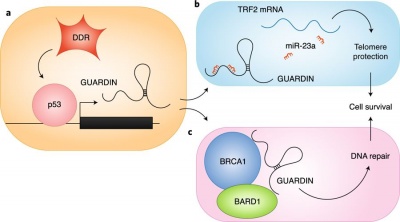Difference between revisions of "GUARDIN"
| Line 51: | Line 51: | ||
<ref name="ref3"> Grossi E & Huarte M. A lncRNA GUARDINg genome integrity[J]. Nature cell biology. 2018, 20(4):371-372.</ref>(3) | <ref name="ref3"> Grossi E & Huarte M. A lncRNA GUARDINg genome integrity[J]. Nature cell biology. 2018, 20(4):371-372.</ref>(3) | ||
</references> | </references> | ||
| − | |||
| − | |||
Revision as of 08:14, 9 November 2018
lncRNA GUARDIN a p53-inducible effector which is critical for guarding the de novo structure of DNA and genomic integrity.[1]
Contents
Annotated Information
Name
GUARDIN
Alias
NA
Characteristics
GUARDIN is located between the genes encoding miR-34a and hexose-6-phosphate dehydrogenase/glucose 1-dehydrogenase (H6PD).[1] This region is part of the FRA1A(aphidicolin type, common, Fra(1)(P36)) fragile site that is frequently lost in human cancers.[2]
Function

GUARDIN has a role in regulation of cell viability [1]
GUARDIN modulates the cytotoxic effect of p53 [1]
GUARDIN is necessary for preventing chromosome end-to-end fusion through maintaining the expression of telomeric repeat-binding factor 2 (TRF2) by sequestering microRNA-23a [3]
GUARDIN interacts with BRCA1 and BARD1 and is essential for the stabilization of BRCA1 [1]
GUARDIN protects genomic integrity through TRF2 and BRCA1 [1]
Regulation
GUARDIN expression is strongly induced following DNA damage.[1] GUARDIN expression is primarily regulated by wild-type p53. [1]
Diseases
GUARDIN silencing triggered apoptosis and senescence, enhanced cytotoxicity of additional genotoxic stress and inhibited cancer xenograft growth. GUARDIN may constitute a target for cancer treatment [3]
Expression
GUARDIN expression is primarily regulated by wild-type p53. However, it was detectable in TP53-null cells and in tumours with mutations in TP53, albeit at low levels.[1]
GUARDIN transcripts were concurrently reduced in a proportion of colon cancers with gene copy number loss.[1]
Labs Working
- Chinese Academy of Sciences (CAS) Key Laboratory of Innate Immunity and Chronic Disease, CAS Centre for Excellence in Cell and Molecular Biology, Innovation Centre for Cell Signalling Network, School of Life Sciences, University of Science and Technology of China, Hefei, China
- Translational Research Institute, Henan Provincial People’s Hospital, Zhengzhou, China
- Department of Gene Therapy and Regulation of Gene Expression, Center for Applied Medical Research, University of Navarra, Pamplona, Spain
References
</references> [1](1) [2](2) [3](3)
</references>- ↑ 1.00 1.01 1.02 1.03 1.04 1.05 1.06 1.07 1.08 1.09 1.10 Hu WL, Jin L, Xu A, Wang YF, Thorne RF, Zhang XD et al. GUARDIN is a p53-responsive long non-coding RNA that is essential for genomic stability[J]. Nature cell biology. 2018, 20(4):492-502.
- ↑ 2.0 2.1 Georgakilas AG, Tsantoulis P, Kotsinas A, Michalopoulos I, Townsend P & Gorgoulis VG. Are common fragile sites merely structural domains or highly organized “functional” units susceptible to oncogenic stress?[J]. Cellular and molecular life sciences. 2014, 71(23):4519-4544.
- ↑ 3.0 3.1 3.2 3.3 Grossi E & Huarte M. A lncRNA GUARDINg genome integrity[J]. Nature cell biology. 2018, 20(4):371-372.